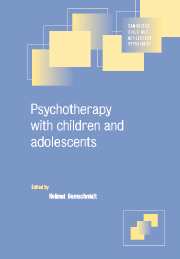Book contents
- Frontmatter
- Contents
- List of contributors
- Preface
- Part I Principles of psychotherapy with children, adolescents and families
- Part II Psychotherapeutic methods and settings
- Part III The practice of psychotherapy for specific disorders in childhood and adolescence
- Part IV The practice of psychotherapy in various settings
- 32 Inpatient psychotherapy
- 33 Day-patient psychotherapy
- 34 Home treatment
- Index
32 - Inpatient psychotherapy
- Frontmatter
- Contents
- List of contributors
- Preface
- Part I Principles of psychotherapy with children, adolescents and families
- Part II Psychotherapeutic methods and settings
- Part III The practice of psychotherapy for specific disorders in childhood and adolescence
- Part IV The practice of psychotherapy in various settings
- 32 Inpatient psychotherapy
- 33 Day-patient psychotherapy
- 34 Home treatment
- Index
Summary
Introduction
Inpatient psychotherapy is a common approach to treatment of psychogenic disorders in Germany, where more beds for inpatient psychotherapy are available in special hospitals for psychogenic and psychosomatic disorders than in all other countries together (Schepank, 1987; Schepank and Tress, 1988). In contrast, child and adolescent psychiatric hospitals have very few specific psychotherapy units for children and adolescents. Therefore, inpatient psychotherapy in childhood and adolescence is usually undertaken on general child and adolescent psychiatric wards.
Fig. 32.1 shows the age and sex distribution of inpatients treated at the Hospital for Child and Adolescent Psychiatry, University of Marburg (Germany). The majority (73%) of inpatients were 12 years old or older. A breakdown of patients by diagnosis (Fig. 32.2) shows that over half were admitted for the treatment of disorders which are overwhelmingly psychotherapeutically managed, e.g. anorexia nervosa, neuroses, specific emotional disorders, adjustment disorders. This serves to demonstrate the central role of psychotherapy in the management of children admitted to child and adolescent psychiatry departments.
Indications for inpatient psychotherapy
After the indication for inpatient treatment has been decided upon (see Chapter 2 for choice of treatment), the issue of selecting an appropriate treatment modality needs to be addressed. It is possible to distinguish four different treatment modalities:
inpatient treatment,
partial hospitalization (day-patient treatment),
treatment in the usual environment (home-treatment), and
outpatient treatment.
- Type
- Chapter
- Information
- Psychotherapy with Children and Adolescents , pp. 539 - 551Publisher: Cambridge University PressPrint publication year: 2001



